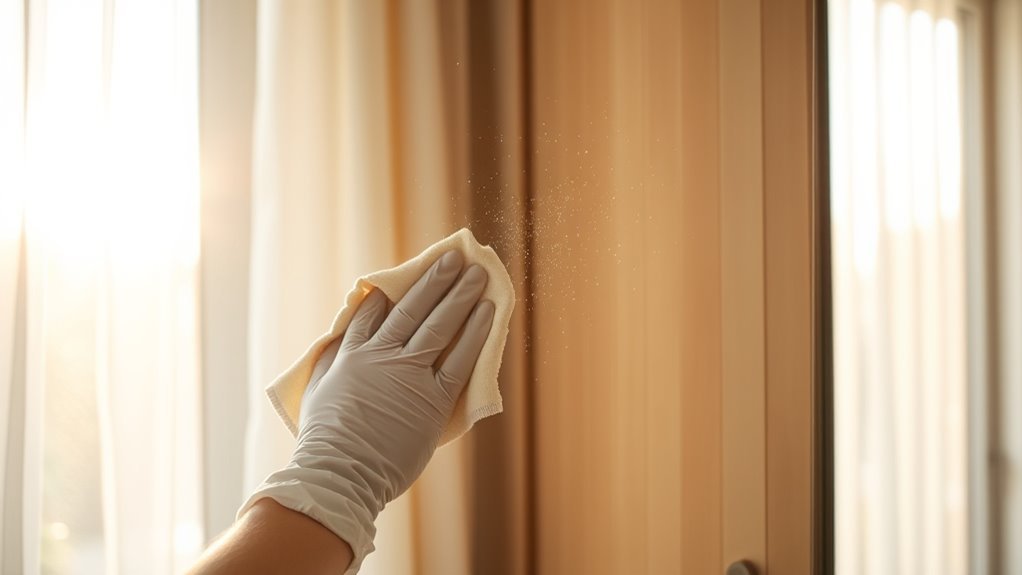How to Clean Blinds and Curtains Without Damaging Them
To clean your blinds and curtains without damage, first identify their material—wood, fabric, vinyl, or aluminum—as each needs different care. Use gentle tools like microfiber cloths and mild detergents, avoiding soaking wooden blinds to prevent warping. For curtains, check care labels and wash gently or spot clean stains promptly with mild solutions. Regular dusting and protecting from harsh sunlight will keep them fresh longer. Keep going to discover detailed steps and expert tips for lasting results.
Understanding Different Types of Blinds and Curtains

Before you start cleaning, it’s important to know what kind of blinds or curtains you have. Different types of materials—like wood, aluminum, fabric, or vinyl—need specific cleaning methods to avoid damage. For instance, wooden blinds can warp if soaked, so you’ll want to dust or lightly wipe them. Fabric curtains might require gentle vacuuming or spot cleaning, while vinyl blinds can often handle a more thorough wash. Understanding the material helps you choose the right approach, preserving your freedom from tedious trial-and-error or costly replacements. Knowing these details allows you to clean effectively and confidently, keeping your space fresh without limiting your time or energy. So, take a moment to identify your blinds or curtains before diving in—it’s the key to hassle-free upkeep.
Preparing Your Cleaning Supplies and Environment
Gathering the right cleaning supplies is the first step to making your blinds and curtains look fresh without causing damage. Start by selecting gentle cleaning tools suited to your window treatments, like microfiber cloths, soft brushes, and mild detergents. Avoid harsh chemicals that could restrict your freedom to clean without worry. Next, organize your workspace to keep everything within reach—this saves time and lets you move freely around your blinds and curtains. Clear the area of obstacles and protect surrounding surfaces from drips or dust. A well-prepared environment helps you clean efficiently and confidently, so you’re not stuck scrambling for supplies mid-task. By setting up thoughtfully, you’re free to enjoy a smooth, damage-free cleaning process that breathes new life into your blinds and curtains.
Step-by-Step Cleaning Process for Blinds

With your supplies ready and workspace set, you can start cleaning your blinds systematically to avoid missing spots or causing damage. First, close the blinds fully and use a microfiber cloth or a duster designed for blinds as your primary cleaning tools. Gently run the duster or cloth along each slat, starting at the top and working your way down, to remove loose dust efficiently. For deeper cleaning, mix mild soap with water, dampen a cloth, and wipe each slat carefully. Avoid soaking the blinds to prevent warping or damage. After cleaning, open the blinds and inspect for missed areas, repeating dusting techniques as needed. Following this step-by-step process lets you maintain your blinds’ freedom from dirt without risking harm.
Techniques for Washing and Drying Curtains Safely
Cleaning curtains safely involves a few key steps to protect their fabric and colors. First, always check the care label for specific fabric care instructions. If machine washing is allowed, use a gentle cycle with cold water and mild detergent to avoid shrinking or fading. For delicate fabrics, hand washing is your best bet—gently agitate the water without wringing. When it comes to drying methods, avoid the dryer unless the label says otherwise. Instead, hang your curtains to air dry, which preserves their shape and reduces damage. If you must use a dryer, choose a low heat setting and remove curtains while still slightly damp. By following these techniques, you’ll keep your curtains looking fresh, vibrant, and ready to brighten your space freely.
Spot Cleaning Tips for Stubborn Stains

Although stubborn stains on blinds and curtains can be frustrating, tackling them promptly can prevent permanent damage. When you spot a stain, first identify the fabric type; delicate materials like silk or lace need gentler approaches than heavy cotton or synthetic blends. For stain removal, start with a mild detergent mixed with water and test it on a hidden area to avoid discoloration. Use a soft cloth or sponge to dab the stain gently—never rub, as that can spread or embed it further. For tougher stains, a vinegar solution or specialized stain remover designed for your fabric type can work wonders. Acting quickly and choosing the right method lets you preserve your window treatments without sacrificing their look or feel.
Preventative Care to Maintain Cleanliness Longer
If you want your blinds and curtains to stay fresh longer, adopting simple preventative care habits can make a big difference. Start with regular dusting—this quick step prevents dirt buildup and keeps fabrics looking vibrant. Use a microfiber cloth or a vacuum with a brush attachment to gently remove dust without damaging fibers. Preventative maintenance also involves controlling environmental factors; for example, keep windows closed during dusty days and use air purifiers to reduce airborne particles. Avoid exposing your curtains and blinds to direct harsh sunlight for extended periods, as this can fade colors and weaken materials. By integrating these effortless habits into your routine, you’ll extend the life of your window treatments and enjoy a cleaner, freer space without constant deep cleaning.
Frequently Asked Questions
Can I Use a Vacuum Cleaner on All Types of Blinds?
You can use a vacuum cleaner on most blinds, but it really depends on the blinds materials. For example, wood or fabric blinds need gentle care, so you’ll want to use soft vacuum attachments to avoid damage. Vinyl or aluminum blinds are more durable and usually handle vacuuming well. Just make sure to set your vacuum to a low suction setting and choose the right attachment, so you keep your blinds looking fresh without risking harm.
How Often Should I Deep Clean My Curtains?
You should aim to deep clean your curtains every 6 to 12 months, depending on your lifestyle and environment. For curtain maintenance tips, regularly vacuum or gently shake them out to prevent dust buildup between deep cleans. If you have pets or allergies, consider cleaning more often. Sticking to this deep cleaning frequency keeps your curtains fresh and extends their life, giving you the freedom to enjoy a clean, inviting space without hassle.
Are There Eco-Friendly Cleaning Products Safe for Blinds?
Absolutely, you can use natural cleaning solutions that are gentle yet effective on blinds. DIY eco-friendly options like a mix of vinegar, water, and a few drops of essential oil work wonders without harsh chemicals. You’re free to customize your blend, ensuring it’s safe for your blinds and the environment. This way, you maintain cleanliness without sacrificing the planet or your freedom to choose what’s best for your home.
Can Sunlight Damage My Curtains During Drying?
Yes, sunlight can damage your curtains during drying, especially if they have vibrant curtain colors that may fade over time. You’ll want to contemplate gentle drying methods like air-drying in the shade or using a low-heat setting in a dryer. Protecting your curtains lets you enjoy their colors longer, giving you the freedom to style your space without worrying about sun damage. Always check care labels for best results.
What Should I Do if My Blinds Are Warped After Cleaning?
If your blinds are warped after cleaning, don’t worry—you’ve got options! Start by trying some blinds restoration tips like gently applying heat with a hairdryer while reshaping the slats. For more stubborn warped material solutions, you can place the blinds under weight or use a warm iron with a cloth barrier. These simple tricks help restore flexibility and shape, giving your blinds a fresh, free-flowing look without needing replacement.






